FAQ
Are there any negative side effects?
Red Light Therapy is a safe and painless treatment.
Red light therapy is distinctive to other light-based therapies because it promotes beneficial healing without inflicting damage on the body. IPL (intense pulsed light) or laser improves the appearance of the skin by causing controlled injury to the outer layer to stimulate collagen regeneration.
Red light and NIR wavelengths penetrate below the skin’s surface, stimulating deep healing and cellular regeneration without harming the outer epidermis. Regular red light therapy sessions with Red Lab’s top-quality devices revitalise the cells from the inside out. There is zero pain, heat, or sensation during the treatment itself. Also, red light therapy carries no known serious side effects.
How often should I practice red light therapy?
The range is from two times per week to two times per day (per target area). However, the more frequently you do sessions within this range, the greater your results will be.
How long before I will see results?
Using red light therapy is a long-term commitment to your health, at a cellular level. While you may notice a healthy glow after the first treatment, each person responds at different rates. Factors that influence this include various physical conditions, age, diet, alcohol consumption, prescription drug usage, smoking, exercise, etc.
Mitochondrial dysfunction refers to low-energy cells that can’t perform at their peak and become easily damaged or die prematurely. This is at the root of many signs of ageing. Once cellular functioning is restored, you will start to see and feel changes in your skin, but it still takes time for a youthful appearance to be restored. Skin cells take about a month to regenerate, and not all cells regenerate at the same time. It may take a few weeks to see results, and a few months to achieve a significant reduction of fine lines, wrinkles, and rejuvenated skin.
Remember: With LLLT you’re treating the underlying problem that causes ageing skin, rather than just temporarily filling in existing fine lines and wrinkles and plumping and firming papery skin. LLLT is a cosmetic treatment, but at a cellular level, which is far more effective in the long term than any surface treatments.
We recommend a 12 week (3 month) intensive treatment regime (3-4 sessions per week) and thereafter a maintenance programme of 4 sessions per month (1-2 sessions per week) for optimal results.
Why are LED lights preferable to halogen or laser?
The optimal Red Light and NIR technology is done by LED as you are able to control the surface temperature. Also, LED disperses over a larger surface area than a halogen or laser light. Another major difference between LED and halogen and laser is the way light energy is delivered (optical power output – OPD). The OPD of LED is measured in milliwatts and laser and halogen are measured in watts. This allows LED to have a gentler delivery that will not damage tissue or risk accidental eye injury. Also with LED, light disperses over a greater surface area to give a faster treatment time.
Are our lights medically approved?
All RED LAB therapy lights are official FDA Class II Medical Devices and manufactured in an FDA registered facility.
Is Red Light Therapy safe?
YES! It has been proven in numerous studies that Far Red to Near- Infrared LED photo rejuvenation does not harm the human body. The energy delivered is safe for all skin types. Red Light Therapy is a safe and painless treatment. Red light therapy is distinctive to other light-based therapies because it promotes beneficial healing without inflicting damage on the body. IPL (intense pulsed light) or laser improves the appearance of the skin by causing controlled injury to the outer layer to stimulate collagen regeneration. Red Light and NIR wavelengths penetrate below the skin’s surface, stimulating deep healing and cellular regeneration without harming the outer epidermis. Regular Red Light Therapy sessions with RED LAB’s top-quality devices revitalise the cells from the inside out. There is zero pain, heat, or sensation during the treatment itself. Also, red light therapy carries no known serious side effects.
Can you have too much red light exposure?
In short, no, you can not get too much Red Light Therapy. According to Michael Hamblin – associate professor at Harvard Medical School and a noted expert on red light therapy – “You could use RLT for 24 hours a day and wouldn’t damage the skin. It’s almost impossible to cause any harm.” However, while Red Light is side-effect-free, temporary tightness or redness is possible if you have sensitive skin. This can be alleviated by reducing the treatment time or moving farther back from the device. But overall, red light therapy is very safe.
Do I need eye protection?
Eye protection isn’t necessary, but we don’t recommend looking directly into the LEDs as it can be uncomfortable. For this reason, we provide a pair of optional light-blocking goggles for your comfort.
Do I wear clothing for my treatments?
It is important to make sure the area of your body you are treating is fully exposed to the light and not covered by any fabric or clothing. Areas not being treated may be covered if you are more comfortable.
What about EMF (Electromagnetic Field)? Do the lights emit EMF?
In short, all electrical devices that use electricity to operate will indeed generate some type of EMF as a by-product of electrical consumption. However, thanks to the advanced shielded components used in all of our lights, RED LAB therapy lights have ZERO detectable EMF emissions at the minimum usage distance.
What are the health benefits of Red Light and NIR Light Therapy?
As Ari Whitten, a #1 best-selling author and the creator of the Energy Blueprint system for overcoming fatigue and increasing energy levels, says: “If there were a drug that had scientific research showing all these benefits, it would be an absolute blockbuster drug for pharmaceutical companies – it would be hailed as a ‘miracle drug’ and prescribed to basically everyone. Here’s the best part: That ‘drug” exists. It’s just not in the form of a pill. It’s in the form of NIR and red light therapy!”
The most significant benefit of red light therapy is the effect it has on the body’s cells. When our cells are provided with support to operate at or close to their optimum efficiency, the benefits for health and well being are countless. One of the most critical outcomes of red light therapy on cellular function is the stimulation of collagen production.
Collagen is the most common protein found in the body, constituting 70% of the proteins found in the skin (our largest organ) and 30% of the proteins found in the body. Collagen strengthens hair, is responsible for the health of connective tissue, and provides our skin with firmness and elasticity. As we age, collagen production decelerates, resulting in thinner, looser skin. The result is a more wrinkled appearance.
Since red light therapy restores cellular function, collagen production is also increased. As a consequence, individuals who regularly use red light therapy report that not only do they feel better and heal faster, but their appearance is more youthful and refreshed.
Red and NIR light therapy has been shown to:
Reduce chronic inflammationImproves immune system Build resilience to stress at the cellular levelCombat some autoimmune conditions and improves thyroid function (example – reduction in Hashimoto’s TPO antibodies by 39%)Improve hormonal health (for example, by restoring the liver, important for your thyroid and estrogen)Optimize your brain and cognitive function; increases neuroprotectionImproves mood, depression, and anxietyIncrease fertilityOvercome fatigue and improve energy levels, and helps with sleep Fight the oxidative damage that drives agingDecrease pain (examples: low back pain, chronic pain, joint pain, and fibromyalgia)Increase strength, endurance, and muscle mass; increases collagen production Speed up wound/injury healingFight skin aging, wrinkles, hyperpigmentation, skin conditions, and celluliteLose fat (nearly twice as with diet and exercise alone) Helps hair regrowth Regenerates stem cells
How does red light therapy reduce inflammation?
Near-infrared light reduces overall inflammation in the body by decreasing the presence of inflammatory markers. This reduction can help ease the symptoms associated with joint pain, sore muscles, autoimmune diseases, arthritis, traumatic brain injuries, and spinal cord injuries.
How does red light therapy reduce pain?
In one clinical study, neuropathic pain caused by a spinal cord injury was dramatically reduced by the application of red light treatment. Scientists conducting the study referred to it as “as an exciting prospect with significant clinical relevance.” Near-infrared light wavelengths reduce overall pain by easing joint stiffness and soreness, diminishing inflammation, easing muscles spasms and enhancing blood flow.
How does red light therapy reduce recovery times after training and injury?
For high-performance athletes (and those who train like them) red light therapy can help accelerate muscle repair following fatigue and injury. Mitochondria within cells are particularly responsive to red light therapy, and muscles cells are exceptionally rich in mitochondria. Red light therapy may additionally stimulate stem cells, further assisting in muscle recovery.
How does red light therapy improve fertility and increased testosterone levels?
Around the age of 30, male testosterone levels naturally start to decrease. Men hoping to achieve a natural boost to their sex drives, sexual satisfaction, fertility, and physical performance can reap benefits from red light therapy. Red and near-infrared wavelengths can stimulate photoreceptor proteins in the testes causing higher testosterone production. Other studies have theorised that low-level light therapy may affect the pineal gland in the brain, which bears a significant impact on reproduction.
How many treatments are required?
When people are considering red light therapy as a treatment method, a question we often hear is, “How often should I use red light therapy?”. This should be a commitment. Results will not be achieved in just a few sessions, or going “occasionally”. We strongly recommend 3 to 4 sessions per week for the first 12 weeks. Continuous use accelerates cellular activity and fuels the collagen and elastin process. After your first 12 weeks, we recommend 1-2 sessions per week thereafter for maintenance and prevention.
But keep in mind that there’s actually no one-size-fits-all dosage for red light therapy. Everyone has unique treatment needs.
It’s a scientific fact that no two people are exactly the same. Just as each person has unique DNA, fingerprints, ears, and teeth, everyone has unique health needs and responds differently to treatments. With that in mind, your optimal red light dosage depends on the condition(s) you want to treat, your overall health, and your light sensitivity.
CONDITION(S) BEING TREATED
Some effects, like muscle recovery or improvement in skin tone, can happen quickly after red light application. Other effects take more time. That’s because results depend on improved cellular health and other biological processes that occur when red light stimulates cells. For chronic conditions, a realistic expectation for results is from one to four months. After you’ve achieved your desired results, ongoing sessions can help maintain improvements in skin tone, pain management, muscle health, and hair regrowth.
YOUR OVERALL HEALTH
If you’re in poor health and suffer from several chronic conditions, waiting for results from red light therapy may be frustrating- but be patient and stick with it. Red light heals from within, at the cellular level. It promotes optimal functioning of cells, which means the body’s natural healing mechanisms go to work on a wide variety of conditions. You will likely see a positive ripple effect of health benefits.
YOUR LIGHT SENSITIVITY
In study after study, red light therapy has proven to be safe and side-effect-free. Still, the colour, tone, and thickness of skin can affect the absorption of red light photons, which may necessitate adjusting your treatment times. And if you are taking photosensitizing medications or have skin cancer, always consult your doctor before using any type of treatment, including red light therapy.
A SMALL SAMPLING OF CONDITIONS
Following are some of the most common conditions that can be effectively treated with red light therapy, along with the typical dosage.
General Skincare/Anti-Aging:
Research has overwhelmingly shown that red light therapy benefits skin in innumerable ways, from improving skin tone to softening the appearance of wrinkles. In one study on skin health, participants used red light twice a week, and they showed significant improvements after 30 sessions. That’s a good starting point for you. Once you’ve achieved the desired results, ongoing sessions will help maintain your skin improvements.
Muscle Healing:
Red light therapy has proved to be effective at stimulating, healing, and regenerating damaged muscle tissue. Many athletes improve their sports performance by using red light for pre-conditioning before exercise, and also after exercise. A 2017 review by researchers from the United States and Brazil found that by combining red and NIR light during treatment, every layer of muscle is treated in both small and large muscle groups. A maintenance program of pre- and post-exercise red light therapy may promote optimal physical performance and help prevent injury.
Before exercise (preconditioning and injury prevention): three to five minutes per day
After exercise (accelerated recovery): 10 to 20 minutes per day at
Injury: 20 minutes per day at 6” to 12” until the injury heals
Hair Loss:
Although it may sound too good to be true, red light therapy really has been proven to regrow hair. One of many studies was conducted during 2017 and involved 90 patients aged 18 to 70. All participants suffered from androgenic alopecia, which is the scientific term for baldness. Those who were treated with red and NIR light showed “statistically significant improvement” in hair growth.
To stimulate hair regrowth, use red light for 10 to 20 minutes three to five times per week. Once hair starts to grow, a maintenance program will continue stimulating normal hair growth.
Arthritis Joint Pain:
Red light has been shown to relieve pain and increase mobility for many arthritis patients.
One study of 50 elderly patients with degenerative osteoarthritis showed great results using red/NIR light for 15 minutes twice daily. Ongoing maintenance treatment may slow the progression of osteoarthritis and other degenerative joint disorders, while continuing to relieve pain.
Chronic Skin Disorders:
People with chronic skin disorders such as eczema, psoriasis, and rosacea, endure a great deal of suffering, from severe itching to burning pain. Research has shown that these disorders can be effectively treated with red light therapy.
One study, for example, involved patients with psoriasis who had no success with conventional therapy methods. After being treated with a combination of red light and NIR light (630 nm and 830 nm) in two 20-minute sessions every other day for four or five weeks, their skin was noticeably improved.
Consistent exposure to red light therapy can reduce symptoms and promote skin health. Start with 10- to 20-minute sessions. Continue this program three to five times per week for one to four months, followed by a maintenance program.
Skin Wounds and Scars:
Because red light therapy energises cells and stimulates collagen production, it can effectively treat skin wounds and minimise the appearance of scars. One major research review that confirmed this was conducted in 2014 by researchers from Brazil. They concluded that red light therapy effectively treats skin wounds, which minimises scarring.
For skin wounds, stretch marks, and mild scars, a good treatment program is 10- to 20-minute red light sessions three to five times per week for a period of one to four months. This will stimulate collagen production to soften and minimise scars, although older and/or deeper scars may require longer treatment.
Low Back Pain:
An estimated 80 percent of adults are affected by low back pain at some point during their lives. It’s a leading cause of job-related disability, and depending on severity, can significantly impair quality of life for those who suffer from it.
If you’re one of them, the good news is that red light therapy can be very effective in treating low back pain. This includes both acute (short-term, often injury-related) and chronic (longer-term). One study from. 2006 found that patients with low back pain who were treated with infrared therapy (800 nm to 1200 nm) had a 50 percent reduction in pain over six weeks.
For your low back pain, 10- to 20-minute sessions daily (remain seated if it’s more comfortable for you). Ongoing treatment can significantly relieve chronic low back pain.
Do I need to do anything before my sessions?
Remove any makeup or cream – especially if it has an SPF factor.
Can red light therapy be used on someone who has been treated recently with Botox® injections?
The light would cause no harm to the tissue, however, since it has a regenerative effect it might shorten the life of the paralyzing effect of Botox®, so the person might want to avoid using the light around the injected areas until the Botox® wears off.
Does the skin feel different?
The treatments and results begin within the skin, right at the heart of the cell. After the first treatment the skin feels tighter, more alive. Due to the increased circulation, oxygenation and moisture, you will notice a softening of the lines and folds, an increase of inner skin firmness as a result and healthy glow and skin rejuvenation.
Our Products
-
 Sold out
Sold outHandheld Unit
Regular price R 1,950.00Regular priceUnit price perR 2,999.00Sale price R 1,950.00Sold out -
 Sold out
Sold outTarget Light
Regular price R 1,795.00Regular priceUnit price per







